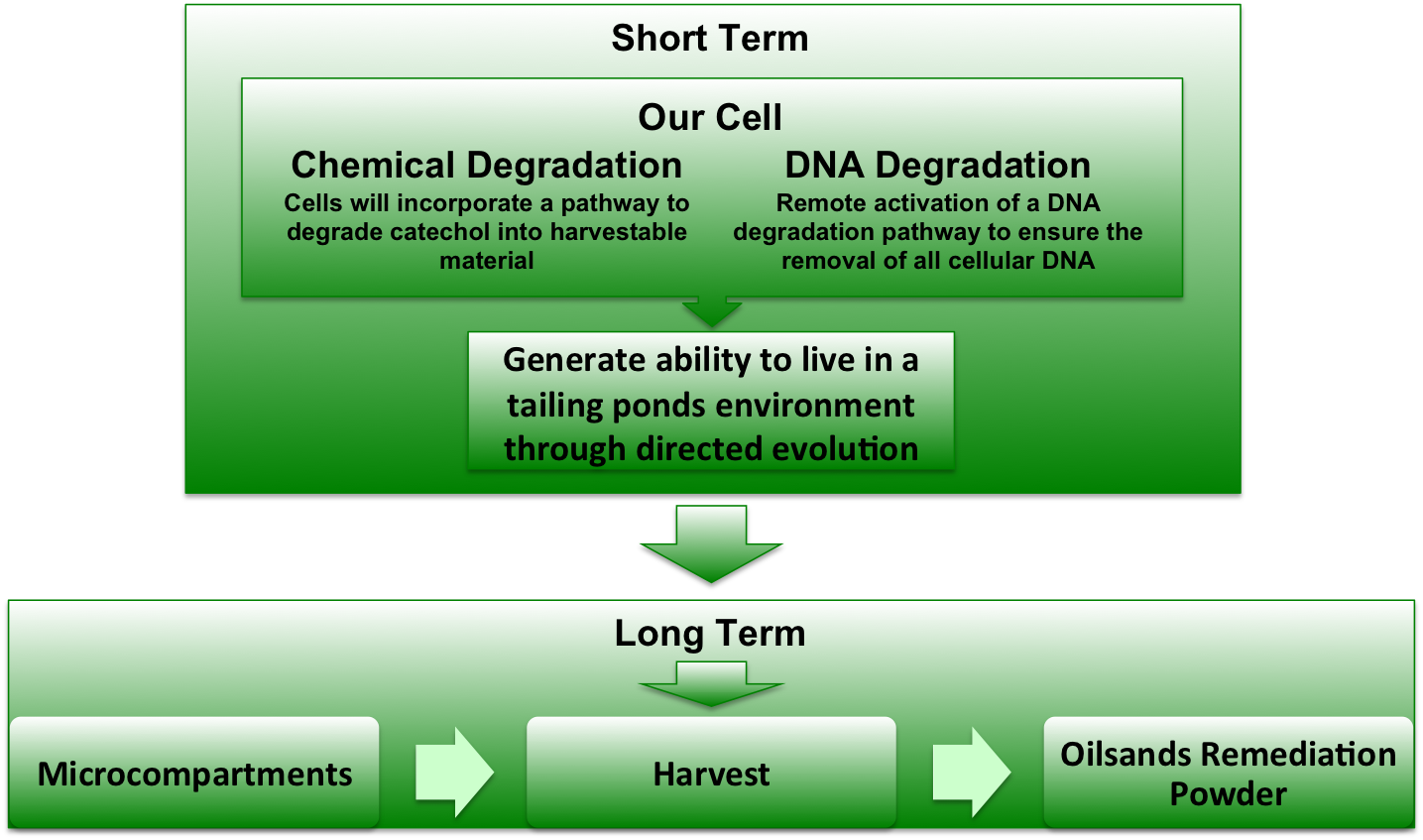Team:Lethbridge/Project
From 2010.igem.org
Liszabruder (Talk | contribs) |
Liszabruder (Talk | contribs) |
||
| Line 154: | Line 154: | ||
<ol> | <ol> | ||
| - | <li>Bacteria have been found in tailings ponds and even in asphault. They have been shown to be able to degrade many organic compounds in nature. The pathways responsible for degradation of aromatic hydrocarbons produce catechol, a colourless, ortho-substituted benzene with two hydroxyl groups as an intermediate. Our goal is to increase the rate of catechol degradation by optimizing the pathway for introduction into the tailings. We will use a pathway which degrades catechol into a semialdehyde which is usable by the bacteria and can be further degraded into usable resources such as ethanol or methanol.</li> | + | <li>Bacteria have been found in tailings ponds and even in asphault. They have been shown to be able to degrade many organic compounds in nature. The pathways responsible for degradation of aromatic hydrocarbons produce catechol, a colourless, ortho-substituted benzene with two hydroxyl groups as an intermediate. Our goal is to increase the rate of <html><a href="https://2010.igem.org/Team:Lethbridge/Project/Catechol_Degradation"><font color="green">catechol degradation</font></a></html> by optimizing the pathway for introduction into the tailings. We will use a pathway which degrades catechol into a semialdehyde which is usable by the bacteria and can be further degraded into usable resources such as ethanol or methanol.</li> |
| - | <li>Previous iGEM teams have been able to remotely activate E coli’s | + | <li>Previous iGEM teams have been able to remotely activate <i>E coli’s</i> <html><a href="https://2010.igem.org/Team:Lethbridge/Project/DNA_Degradation"><font color="green">DNA degradation pathway</font></a></html> which is the pathway responsible for terminating the cell. This is a very powerful tool, as part of the apoptosis pathway degrades the cell’s DNA. By providing the ability to destroy our custom cell through DNA degradation, we ensure that the cell will not escape into the environment, the DNA will be degraded eliminating the potential for horizontal gene transfer between other species present in the tailing ponds, and the relevant enzymes will not be destroyed.</li> |
| - | <li>Our iGEM project last year was the assembly of synthetic microcompartments to isolate pathways from the rest of the cellular environment. These microcompartments will be used to house the catechol degradation pathway so that the pathway can be isolated from the cell and administered to the tailings in a powdered form.</li></ol> | + | <li>Our iGEM project last year was the assembly of <html><a href="https://2010.igem.org/Team:Lethbridge/Project/Compartamentalization"><font color="green">synthetic microcompartments</font></a></html> to isolate pathways from the rest of the cellular environment. These microcompartments will be used to house the catechol degradation pathway so that the pathway can be isolated from the cell and administered to the tailings in a powdered form.</li></ol> |
===<font color="white">Optimization=== | ===<font color="white">Optimization=== | ||
| - | Using selective evolution in the presence of catechol we will engineer an E. coli which is able to live in high concentrations of catechol. This will allow for optimization of the catechol degradation pathway using. The next step will be to further use selective evolution with the tailings sample so that the pathway will be optimized for the environmental conditions that the pathway will administered to. | + | Using selective evolution in the presence of catechol we will engineer an <i>E. coli</i> which is able to live in high concentrations of catechol. This will allow for optimization of the catechol degradation pathway using. The next step will be to further use selective evolution with the tailings sample so that the pathway will be optimized for the environmental conditions that the pathway will administered to. |
===<font color="white">Our Expectations=== | ===<font color="white">Our Expectations=== | ||
| Line 171: | Line 171: | ||
====<font color="white">Short-term Goals==== | ====<font color="white">Short-term Goals==== | ||
| - | We expect to have the biobrick parts submitted to the registry for all of the separate modules. Once we have the biobrick parts we will then be able to assemble the proposed system of the catechol degradation pathway, induced cell death and microcompartments. Our short-term goal will be to provide characterized biobricks for the degradation of catechol in tailings. | + | We expect to have the <html><a href="https://2010.igem.org/Team:Lethbridge/Parts"><font color="green"> biobrick parts submitted</font></a></html> to the registry for all of the separate modules. Once we have the biobrick parts we will then be able to assemble the proposed system of the <html><a href="https://2010.igem.org/Team:Lethbridge/Project/Catechol_Degradation"><font color="green"> catechol degradation pathway</font></a></html>, <html><a href="https://2010.igem.org/Team:Lethbridge/Project/DNA_Degradation"><font color="green"> induced cell death</font></a></html> and <html><a href="https://2010.igem.org/Team:Lethbridge/Project/Compartamentalization"><font color="green"> microcompartments</font></a></html>. Our short-term goal will be to provide characterized biobricks for the degradation of catechol in tailings. |
====<font color="white">Medium-term goals==== | ====<font color="white">Medium-term goals==== | ||
 "
"














